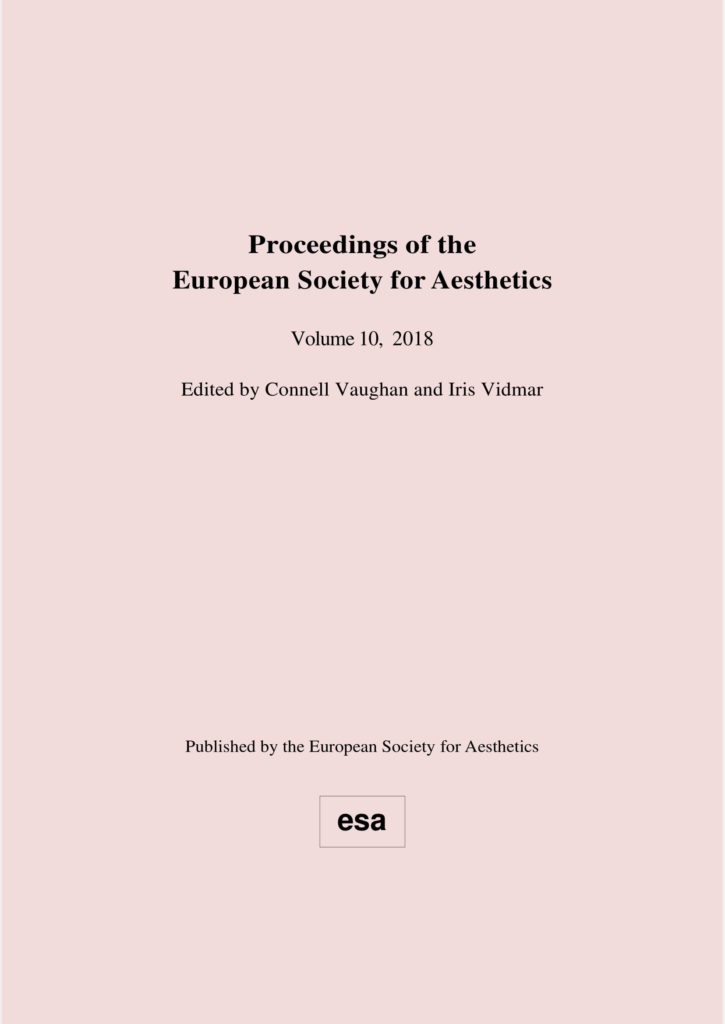|
Claire
Anscomb
|
The
Epistemic Value of Photographs in the Age of New Theory
|
1-18
|
|
Marco
Arienti
| Some Concerns with Experientialism about Depiction: the Case of Separation seeing-in |
19-34
|
|
Marta Benenti and Giovanna Fazzuoli
|
Experiencing
the Making Paintings by Paolo Cotani, Marcia Hafif and Robert Ryman
|
35-54
|
|
Larissa Berger
|
The
Felt Syllogism of Taste – a Reading of Kant’s Sensus Communis
|
55-77
|
|
Nicolò Pietro Cangini
|
Prose
and Life. A Comparison between Hegel’s Aesthetics and Romantic’s Poetics
|
78-92
|
|
Pol Capdevila
|
Poetics
of History in Contemporary Art
|
93-121
|
|
Stephen
Chamberlain
|
Literary
Realism and the Significance of Life
|
122-152
|
|
Melvin Chen
|
To
Chuck or Not to Chuck? Túngara Frogs & Evolutionary Responses to the
Puzzle of Natural Beauty
|
153-166
|
|
Zoë
Cunliffe
|
Epistemic
Injustice and the Role of Narrative Fiction
|
167-179
|
|
Laura
T. Di Summa-Knoop
|
Defining
Fashion: Novelty, Play, and Identity
|
180-203
|
|
Daniel Dohrn
|
Art
avant la Lèttre
|
204-211
|
|
Nemesio García-Carril Puy
|
Against
Hazlett’s Argument: Musical Works Qua Types are Modally Flexible Entities
|
212-234
|
|
Lisa Giombini
|
Material
Authenticity in Conservation Theory
|
235-259
|
|
Vitor
Guerreiro
| The Unity of Our Aesthetic Life: A Crazy Suggestion |
260-288
|
|
Eran Guter and Inbal Guter
|
A
Critique of Langer’s View of Musical Temporality
|
289-307
|
|
Valentina Hribar Sorčan
|
La
Vie et la Mémoire
|
308-328
|
|
Eda
Keskin
|
Everyday
Aesthetics and Empathy Development
|
329-342
|
|
Lev
Kreft
|
From
Universalism to Singularity, from Singularity to Moralization
|
343-358
|
|
Gloria
Luque Moya
|
Experiencing
the Extraordinary of the Ordinary
|
359-380
|
|
Jerzy
Luty
|
Do
Animals Make Art or the Evolutionary Continuity of Species
|
381-399
|
|
Giovanni
Matteucci
|
The
(Aesthetic) Extended Mind: Aesthetics from Experience-of to Experience-with
|
400-429
|
|
Philip
Mills
|
The
Politics of Poetic Language: An Analysis of Jean-Luc Godard’s Alphaville
|
430-443
|
|
Washington Morales
|
Naturalization
and Reification of the Human Global Subjective Experience in Some Forms of
Scientific and Technological Art
|
444-458
|
|
Ancuta
Mortu
| Aesthetic Cognition and Art History |
459-481
|
|
Dan
O’Brien
|
Cubism
and Kant
|
482-506
|
|
Una
Popović
|
The
Birthplace of Aesthetics: Baumgarten on Aesthetical Concepts and Art
Experience
|
507-523
|
|
Matthew
Rowe
|
Minimalism:
Empirical and Contextual, Aesthetic and Artistic
|
524-543
|
|
Salvador
Rubio Marco
|
Manipulating
the Spectator’s Moral Judgments: a Criticism of the Cognitivist Approach in
Cinema
|
544-556
|
|
Marcello
Ruta
| Hermeneutics and the Performative Turn; The Unfruitfulness of a Complementary Characterisation |
557-597
|
|
Sue Spaid
| Are Art and Life Experiences “Mostly Perceptual” or “Largely Extra-perceptual” |
598-619
|
|
Daniela
Šterbáková
|
John
Cage’s 4′ 33′′: Unhappy Theory, Meaningful Gesture
|
620-642
|
|
Polona Tratnik
|
Challenging
the Biopolitical through Animal-Human Hybridization
|
643-658
|
|
Andreas Vrahimis
|
Aesthetics,
Scientism, and Ordinary Language: A Comparison between Wittgenstein and
Heidegger
|
659-684
|
|
Weijia Wang
|
Kant’s
Two Approaches to the Connection between Beauty and Morality
|
685-697
|
|
Ken
Wilder
|
Rosalind
Krauss: From ‘Sculpture in the Expanded Field’ to the ‘Spectacle’ of
Installation Art
|
698-721
|
|
Mark
Windsor
|
Tales
of Dread
|
722-736
|
|
Lorraine Yeung
| Art and Life: The Value of Horror Experience |
737-763
|
